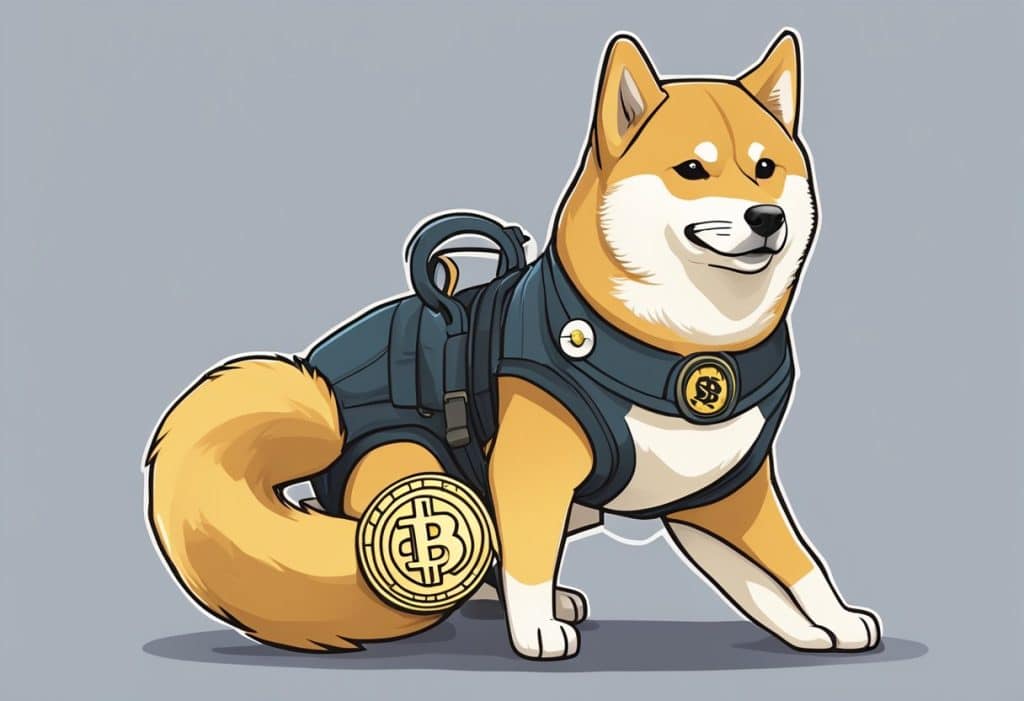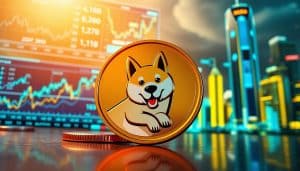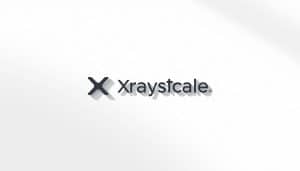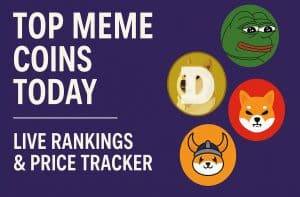Dogecoin and Shiba Inu are two of the most popular meme coins in the cryptocurrency world. These coins have captured the imaginations of investors with their unique origins and vibrant communities. While Dogecoin started as a joke inspired by the Doge meme featuring a Shiba Inu, it has since grown to become the 10th largest cryptocurrency by market cap.
Shiba Inu, often dubbed the ‘Dogecoin killer,’ follows closely but still holds a lot of potential. Created as an experiment in decentralized community building, Shiba Inu aims to bring the fun of memes to the crypto space. Yet, there are significant differences in their tokenomics, market performance, and community impact that set them apart.
Both coins have had their ups and downs, but their continuing popularity shows the growing influence of meme coins in the larger cryptocurrency market. Whether you are considering them for their investment potential or just fascinated by their cultural impact, these coins are more than just internet jokes—they’re a crucial part of the evolving digital finance landscape.
Key Takeaways
- Dogecoin was inspired by a meme and ranks 10th in market cap.
- Shiba Inu is known as the ‘Dogecoin killer.
- Both coins play significant roles in the crypto market.
Origins and Founders

Dogecoin and Shiba Inu, both meme-based cryptocurrencies, have unique beginnings, driven by their respective creators with distinct goals. Understanding their origins helps illuminate their paths towards becoming popular in the crypto world.
Creation of Dogecoin
Dogecoin was created by Jackson Palmer and Billy Markus. In 2013, Palmer, based in Australia, mocked the hype around cryptocurrencies by tweeting about investing in Dogecoin. Markus, a software engineer from Portland, reached out to collaborate. Together, they launched Dogecoin on December 6, 2013, inspired by the “Doge” meme, featuring a Shiba Inu dog with comic text.
Elon Musk has often tweeted about Dogecoin, significantly influencing its popularity and market value. Initially intended as a joke, Dogecoin gained a large community of supporters and became known for its charitable contributions, including donations to fund clean water projects in Kenya.
Birth of Shiba Inu
Shiba Inu, often called the “Dogecoin Killer,” was created by an anonymous individual known as Ryoshi. Launched in August 2020, Shiba Inu aimed to replicate and build upon Dogecoin’s success, leveraging the same Shiba Inu dog theme. It was created as an experiment in decentralized spontaneous community building.
The founder, Ryoshi, sent a significant portion of Shiba Inu tokens to Ethereum co-founder Vitalik Buterin, who later donated a large amount to various charities. This move not only gained media attention but also helped boost the coin’s legitimacy. As of 2025, Shiba Inu has carved out its niche within the cryptocurrency market, emphasizing decentralization and community involvement.
Technical Aspects
Dogecoin and Shiba Inu rely on distinct technical features that play a crucial role in their operation.
Blockchain Technology
Dogecoin utilizes a blockchain that resembles that of Bitcoin but employs the Scrypt hashing algorithm. This algorithm allows for faster transaction times and lower fees. Dogecoin’s block confirmation time is approximately one minute, enabling roughly 33 transactions per second.
In contrast, Shiba Inu operates on the Ethereum blockchain. Since Shiba Inu is an ERC-20 token, it benefits from Ethereum’s robust security and smart contract functionality. This allows for various decentralized applications (dApps) to interact with Shiba Inu. Ethereum’s network, however, can experience slower transaction times and higher fees compared to Dogecoin’s more straightforward blockchain.
Cryptocurrency Mechanics
Dogecoin and Shiba Inu feature different mechanics in terms of issuance and utility. As of early 2025, Dogecoin ranks as the 10th largest cryptocurrency by market capitalization, with a market cap of about $11.3 billion. It has a circulating supply that grows steadily due to its inflationary model, designed to keep mining incentives active.
Shiba Inu, on the other hand, is the 18th largest cryptocurrency, with a market cap around $5.3 billion. Shiba Inu’s supply was initially set at one quadrillion tokens, partly reduced by burning, where tokens are sent to a dead wallet, permanently removing them from circulation. Shiba Inu leverages Ethereum’s capabilities, which aids in creating a more versatile cryptocurrency ecosystem.
Market Insights

When evaluating Dogecoin and Shiba Inu, it’s important to consider their market capitalization and trading volume. These factors can help you understand their stability, liquidity, and potential risks.
Market Capitalization
Dogecoin currently has a significantly higher market capitalization compared to Shiba Inu. As of early 2025, Dogecoin’s market cap stands at approximately $11.3 billion, making it the 10th largest cryptocurrency. In contrast, Shiba Inu’s market cap is around $5.3 billion, placing it at the 18th spot among cryptocurrencies.
This large difference indicates Dogecoin has a more established position in the market. Dogecoin’s higher market cap can provide somewhat more stability and investor confidence, while Shiba Inu still has room for growth and potential volatility.
Trading Volume and Liquidity
Trading volume and liquidity are crucial for understanding a cryptocurrency’s activity and ease of trading. Dogecoin and Shiba Inu collectively lead the meme coin market, which holds a valuation of $50.7 billion.
In recent months, Dogecoin has shown consistently higher trading volumes compared to Shiba Inu. This higher liquidity makes it easier for investors to buy and sell Dogecoin without significantly impacting its price. Shiba Inu, with lower trading volumes, may face more pronounced price fluctuations during large trades.
These differences in trading volume and liquidity could be important for investors considering short-term trading or long-term investment in either currency. For up-to-date real-time prices and trading volumes, check resources like CoinMarketCap for Shiba Inu.
Cultural and Community Impact
Dogecoin and Shiba Inu have both made a significant mark in digital culture and communities. Their rise has been fueled by internet memes and robust online communities that foster engagement and inclusivity.
Meme Coin Phenomenon
Dogecoin began as a joke, inspired by the Shiba Inu dog meme. Despite its humorous beginnings, it grew into a popular cryptocurrency. Shiba Inu followed, branding itself as the “Dogecoin Killer,” and quickly attracted a large fanbase. Social media platforms like Twitter and Reddit played key roles in spreading these memes and growing their popularity. Elon Musk’s tweets also boosted Dogecoin’s visibility.
Both coins benefit from their meme status, drawing attention from people who might not otherwise be interested in cryptocurrencies. This cultural appeal has made them more than just digital currencies; they are symbols of the internet’s playful side.
Community Initiatives
Dogecoin is known for its strong community spirit. Efforts like sponsoring the Jamaican bobsled team and funding clean water projects highlight this. These initiatives have helped build a loyal and engaged community. In comparison, the Shiba Inu community, known as the “ShibArmy,” actively engages in charitable endeavors and works to increase the coin’s value and utility.
Vitalik Buterin, co-founder of Ethereum, also contributed to the Shiba Inu community by donating Shiba tokens to COVID-19 relief efforts in India. This kind of philanthropy has brought positive attention and credibility to the community. You can see how these coins thrive not just on financial interest but also on community actions and social media collaborations.
Investment and Trading
In this section, you will learn how to buy and sell Dogecoin and Shiba Inu and explore different strategies for investing in these popular cryptocurrencies. Understanding these aspects will help you make informed decisions.
How to Buy and Sell
To buy or sell Dogecoin and Shiba Inu, you need to choose a reputable crypto exchange such as Binance, Gate.io, or Coinbase. First, create an account and complete any necessary verification steps.
Buy:
- Deposit funds into your account.
- Search for the trading pair (e.g., DOGE/USD or SHIB/USD).
- Place a buy order, which can be a market or limit order.
Sell:
- Select the amount of Dogecoin or Shiba Inu you wish to sell.
- Place a sell order.
- Transfer the proceeds back to your bank account or leave them in the exchange if you wish to trade further.
Fees also play a critical role; fees vary by exchange, so be sure to review them beforehand.
Investment Strategies
When investing in Dogecoin and Shiba Inu, having a clear strategy is important. Some popular strategies include:
HODLing: Holding your cryptocurrency long-term with the expectation of future gains. This strategy is often used by those who believe Dogecoin and Shiba Inu will increase in value over time.
Day Trading: Buying and selling within short time frames to capitalize on price fluctuations. This requires careful monitoring of market trends.
Dollar-Cost Averaging: Investing a fixed amount regularly, regardless of the price. This can help reduce the impact of volatility.
Diversification: Spreading your investments across different cryptocurrencies and assets to minimize risk.
Remember, each strategy has its risks and benefits, and the best approach depends on your financial goals and risk tolerance.
Regulations and Security
Understanding the regulatory landscape and security measures for Dogecoin and Shiba Inu is crucial for any investor. This section breaks down the current regulatory standards and key security approaches for these popular cryptocurrencies.
Cryptocurrency Regulations
Dogecoin and Shiba Inu, like all cryptocurrencies, operate within an evolving regulatory environment. Both assets face regulation to ensure transparency and compliance. For instance, certain international regulations for Dogecoin have been put in place to address governance and accountability.
Decentralized finance faces tougher scrutiny due to its borderless nature. Governments are working on frameworks that address anti-money laundering (AML) and know-your-customer (KYC) compliance.
This regulatory landscape aims to protect investors and stabilize the market. However, the decentralized nature of these cryptocurrencies presents challenges in creating uniform policies. Regulators also focus on ensuring that Initial Exchange Offerings (IEOs) and decentralized exchanges comply with the laws.
Security Measures
Both Dogecoin and Shiba Inu prioritize security to protect users and maintain trust. Dogecoin employs a proof-of-work (PoW) mechanism, which relies on decentralized mining to secure transactions. This system helps prevent fraud and ensures a secure network by needing consensus from many parties.
Shiba Inu, on the other hand, is an Ethereum-based token, which benefits from Ethereum’s robust proof-of-stake (PoS) model and additional security measures. The project launched on Uniswap, a decentralized exchange, making it more secure than some centralized platforms.
Shiba Inu’s team did not hold any tokens at launch, encouraging decentralization and reducing risks of concentration. These measures, combined with regular audits and community engagement, help maintain high levels of security.
Ecosystem and Technology
Dogecoin and Shiba Inu both have unique ecosystems and technological frameworks that differentiate them from each other. Dogecoin operates with its own blockchain, while Shiba Inu is based on the Ethereum network, incorporating elements like decentralized exchanges and NFTs.
The Ethereum Ecosystem
Shiba Inu is supported on the Ethereum blockchain, which allows it to utilize Ethereum-based features. This includes smart contracts, decentralized applications (dApps), and a wide range of functionalities. One key component is ShibaSwap, a decentralized exchange that lets users trade tokens and provide liquidity.
Shiba Inu also emphasizes its NFTs known as Shiboshis. These are unique digital assets that can be traded on the Ethereum network. You can see these NFTs play a significant role in the Shiba Inu ecosystem and contribute to its popularity.
Another important aspect of Shiba Inu’s ecosystem is Shibarium, a layer-2 solution that aims to improve scalability and transaction speeds. This addition enhances the overall user experience by reducing costs and increasing efficiency. Together, these elements make the Shiba Inu ecosystem robust and versatile.
Technology Development
Dogecoin uses its own blockchain, which means it doesn’t rely on other networks. The technology includes a block confirmation time of about one minute, allowing around 33 transactions per second. This quick rate is one of Dogecoin’s defining features, making it efficient for small transactions.
Unlike Shiba Inu, Dogecoin does not have a strong focus on smart contracts or decentralized applications. The development team mainly focuses on keeping the system secure and user-friendly. However, this simplicity makes Dogecoin easy to use and integrate.
Shiba Inu, on the other hand, benefits from the Ethereum network’s advanced technology. Features like Doggy DAO enhance community governance, giving users more control over the ecosystem. This decentralized approach ensures that developments and decisions are made collectively, adding another layer of transparency and trust.
By leveraging Ethereum’s capabilities and integrating innovations like Shibarium and ShibaSwap, Shiba Inu shows strong technological advances, setting it apart from Dogecoin’s simpler but reliable system.
Tokenomics and Supply
Understanding the tokenomics and supply of Shiba Inu and Dogecoin is important for anyone interested in these meme coins. Each cryptocurrency has unique characteristics that impact their value and market dynamics.
Shiba Inu Token Details
Shiba Inu (SHIB) operates on the Ethereum blockchain and functions as a decentralized cryptocurrency. At its inception, SHIB had a total supply of one quadrillion tokens. Half of this supply was locked into Uniswap liquidity, making it accessible for trading.
The other half was allocated to Vitalik Buterin, who later burned a significant portion. This burning reduced the circulating supply, aiming to increase SHIB’s scarcity and value. Bone and Leash are other tokens within the Shiba Inu ecosystem, each with limited supply and distinct functions, further enhancing the network’s versatility.
Dogecoin Supply Dynamics
Dogecoin (DOGE) was originally created as a joke, but it has evolved into a widely recognized cryptocurrency. Unlike Shiba Inu, Dogecoin does not have a capped supply. This means there is no maximum number of DOGE that can ever exist.
This inflationary model ensures the continuous minting of new coins, with 5 billion DOGE added each year. As a result, the total supply of Dogecoin grows steadily, influencing its long-term value. Despite this, Dogecoin maintains a strong market presence due to its active community and widespread acceptance. You can learn more about the differences between Dogecoin and Shiba Inu in their tokenomics and supply.
Governance and Community Roles
Dogecoin and Shiba Inu both rely heavily on their communities for governance. Dogecoin’s informal approach contrasts sharply with Shiba Inu’s structured efforts through mechanisms like Doggy DAO.
Governance Mechanisms
Dogecoin governance remains informal, driven by community consensus and popular figures like Elon Musk’s endorsements. Unlike many other cryptocurrencies, Dogecoin does not have a centralized structure or a governance token to make decisions. Instead, key changes are often discussed on social media platforms and forums.
Shiba Inu, on the other hand, uses decentralized governance through the Doggy DAO. This system allows holders to vote on important issues, giving more control to the community. The use of governance tokens in Shiba Inu aids liquidity providers and ensures decisions are more structured and fair.
Community Governance
The Dogecoin community plays a crucial role in its development. Active participation occurs through forums, social media, and community meetings, where users share their concerns and suggestions. This grassroots approach has helped maintain Dogecoin’s relevance and growth despite its informal structure.
Shiba Inu’s community, known as the Shiba Army, is similarly active. With an emphasis on decentralized governance, they engage in tokenomics, including burn mechanisms to manage supply. By leveraging community support through Doggy DAO, users vote on proposals to shape the project’s future, ensuring robust engagement and democratic participation in decision-making processes.
Philanthropy and Social Impact
Dogecoin and Shiba Inu have played significant roles in philanthropy and community outreach. These cryptocurrencies are notable for using their platforms for charitable contributions and engaging with communities worldwide.
Charitable Contributions
Dogecoin’s community is known for its charitable efforts. One of the largest donations involved sending funds to India during the COVID-19 crisis. The community rallied to provide relief, demonstrating the power of social media-driven philanthropy.
Shiba Inu has also engaged in charitable activities. For example, the creators have made donations to animal shelters and other causes. These efforts have highlighted the potential for meme coins to make a real-world impact beyond their initial playful image.
Community Outreach
Dogecoin’s community is not just about memes; it’s about creating a sense of belonging and humor around cryptocurrency. The Shiba Inu dog, the face of Dogecoin, has helped foster a unique and dedicated community.
Community outreach efforts for Dogecoin include social media campaigns and community-driven events. These activities have helped Dogecoin maintain a vibrant and engaged user base, demonstrating its cultural impact beyond just financial transactions.
Shiba Inu’s community is similarly passionate, using social platforms to spread awareness and engage with followers. These efforts have solidified Shiba Inu’s place within the broader crypto culture, reflecting the power of community in driving the success of meme coins.
Challenges and Criticisms
Dogecoin and Shiba Inu both face notable hurdles. Two primary concerns are the price volatility due to their speculative nature and issues surrounding their real-world utility.
Volatility and Speculation
Investing in Dogecoin and Shiba Inu comes with high risk. These coins are classified as memecoins, driven largely by internet culture and celebrity endorsements. This can lead to rapid price swings.
For example, Dogecoin’s price history shows significant spikes and drops, making it unpredictable. Such volatility is a double-edged sword—while some investors might see huge gains quickly, others may experience large losses just as fast.
Real-World Utility Issues
Both Dogecoin and Shiba Inu struggle with real-world utility. These cryptocurrencies lack broad acceptance for day-to-day transactions. They are often seen as speculative assets rather than practical solutions for buying goods and services.
While Dogecoin has seen some adoption in niche markets, like online tipping and donations, it remains limited. Shiba Inu faces similar challenges with few real-world use cases, limiting its growth potential. This lack of utility makes them less attractive for long-term investment compared to other cryptocurrencies with established real-world applications.
Frequently Asked Questions
Dogecoin and Shiba Inu have intriguing histories and community influences. Below are common questions about their market values, origins, and symbolic significance.
How does the market value of Dogecoin relate to the popularity of Shiba Inu memes?
Dogecoin’s market value has seen significant fluctuations, with its popularity often driven by the viral Shiba Inu memes. These memes have contributed to increased interest and investment in Dogecoin.
What originated the Shiba Inu meme associated with Dogecoin?
The Shiba Inu meme featuring “Doge” began in 2010. It showcased a Shiba Inu dog with comical, multicolored text in broken English. This meme became widely popular on social media.
Where can discussions about Dogecoin and its Shiba Inu mascot commonly be found online?
Discussions about Dogecoin and its Shiba Inu mascot are often found on forums like Reddit and Twitter. Communities such as r/dogecoin on Reddit provide active discussions and updates.
What is the significance of the Shiba Inu dog to the Dogecoin community?
The Shiba Inu dog represents the playful and lighthearted nature of Dogecoin. It symbolizes the community’s ethos of fun, generosity, and inclusiveness.
How has the representation of the Shiba Inu influenced the public perception of Dogecoin?
The Shiba Inu image has made Dogecoin easily recognizable. Its friendly and approachable mascot has helped to attract a broad user base, including those new to cryptocurrency.
Who is behind the creation of the Doge meme that inspired Dogecoin?
The Doge meme was popularized by Atsuko Sato, a Japanese kindergarten teacher, whose Shiba Inu, Kabosu, became an internet sensation. This meme inspired the launch of Dogecoin in 2013.
























 Bitcoin
Bitcoin  Ethereum
Ethereum  Tether
Tether  XRP
XRP  USDC
USDC  TRON
TRON  Lido Staked Ether
Lido Staked Ether  Dogecoin
Dogecoin  Figure Heloc
Figure Heloc  Cardano
Cardano  WhiteBIT Coin
WhiteBIT Coin  Bitcoin Cash
Bitcoin Cash  Wrapped stETH
Wrapped stETH  Wrapped Bitcoin
Wrapped Bitcoin  USDS
USDS  Binance Bridged USDT (BNB Smart Chain)
Binance Bridged USDT (BNB Smart Chain)  Wrapped eETH
Wrapped eETH  Chainlink
Chainlink  Monero
Monero  WETH
WETH  Stellar
Stellar  LEO Token
LEO Token  Zcash
Zcash  Coinbase Wrapped BTC
Coinbase Wrapped BTC  Hyperliquid
Hyperliquid  Ethena USDe
Ethena USDe  Litecoin
Litecoin  Sui
Sui  Avalanche
Avalanche  sUSDS
sUSDS  Hedera
Hedera  Shiba Inu
Shiba Inu  Dai
Dai  USDT0
USDT0  PayPal USD
PayPal USD  Mantle
Mantle  World Liberty Financial
World Liberty Financial  Cronos
Cronos  Toncoin
Toncoin  Ethena Staked USDe
Ethena Staked USDe  Uniswap
Uniswap  Polkadot
Polkadot  Canton
Canton  Aave
Aave  USD1
USD1  Rain
Rain  MemeCore
MemeCore  Bitget Token
Bitget Token